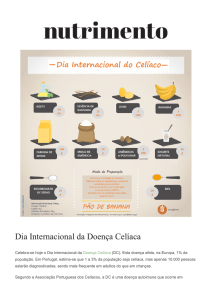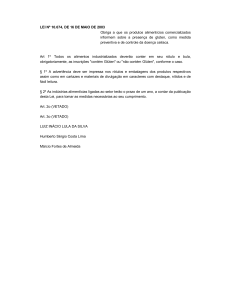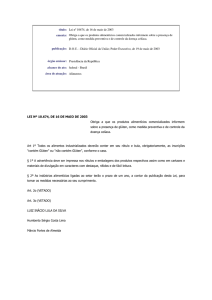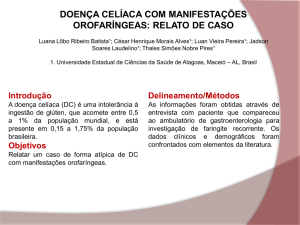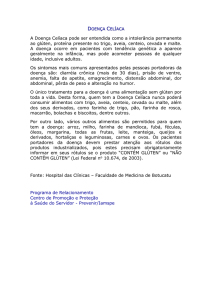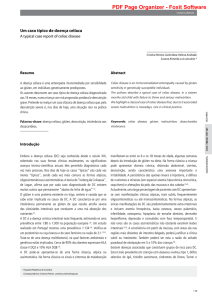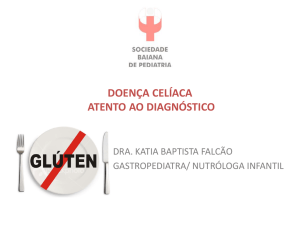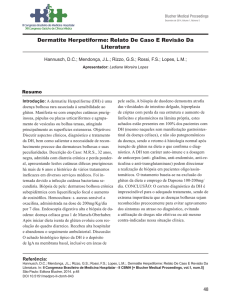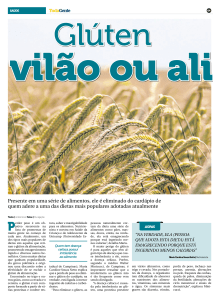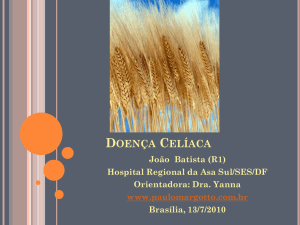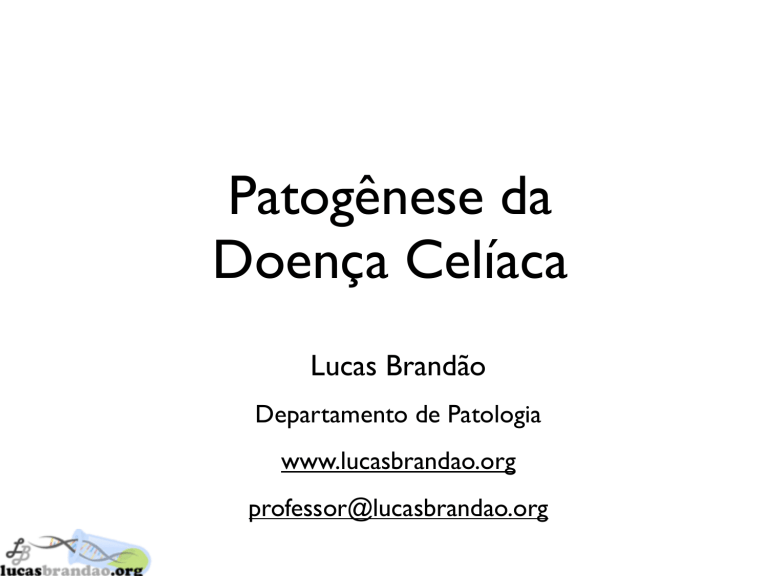
Patogênese da
Doença Celíaca
Lucas Brandão
Departamento de Patologia
www.lucasbrandao.org
[email protected]
O que a
Doença Celíaca?
Enteropatia crônica e permanente
desencadeada pela ingestão de
glúten.
Doença Celíaca
•
É uma intolerância hereditária ao glúten.
•
O glúten é uma proteína encontrada no trigo,
cevada, centeio e aveia.
•
A intolerância é permanente.
•
A inflamação ocorre quando a GLIADINA, um
peptideo derivado do glúten é ingerido e
apresentado pelas células T.
•
IA inflamação causa um dano ao tecido da
mucosa do intestino, especificamente nas
vilosidades que absorvem os nutrientes,
•
Resultado: má absorção dos alimentos.
Uma inflamação?
Uma alergia?
Uma doença autoimune?
Uma doença genética?
Uma doença multifatorial ?
Dados importantes
•
Celiac disease affects as many as 1 in 300 people in
Italy and southwestern Ireland, but is extremely rare
in Africa, Japan, and China (Not et al., 1988).
According to a multicenter study in 2003, there is a
1 in 133 chance that people with no risk factors or
family history in the U.S. have celiac disease.
Additionally,
•
A person’s risk increases to a 1 in 22 chance
if they have a first-degree relative with celiac
disease and a 1 in 39 chance if they have a
second-degree relative (Fasano, 2002). Around
60,000 Americans are diagnosed with celiac disease
annually and a total of over 2 million have the
disease, making it perhaps the most common
genetic disorder in the United States (Westerberg,
et al., 2006). Celiac disease can occur at any age, and
females are more commonly affected than males. Of
females presenting during their fertile years, the
male to female ratio is almost 3 to 1 (Feighery et
al., 1998).
Glúten
Genética
Resposta
Imune
Doença
celíaca
O que a
Doença Celíaca?
Enteropatia crônica e permanente
desencadeada pela ingestão de
glúten que induz uma resposta
autoimmune em indivíduos
geneticamente predispostos.
Uma doença multifatorial
Celiac Disease:
Multifactorial
• Both genetic (main
locus HLA) and
environmental factors
involved in the onset
of the disease
Patogênese da D.C.
Entender...
•
•
•
Glúten;
Genética da doença celíaca;
Resposta imune intestinal na doença celíaca.
Patogênese
FISIOPATOLOGIA
Elementos essenciais para o
desenvolvimento da doença:
•
Ingestão de prolaminas tóxicas,
permanecendo peptídeos tóxicos íntegros;
• Passagem de peptídeos tóxicos através da
barreira mucosa.
FISIOPATOLOGIA
Elementos essenciais para o
desenvolvimento da doença:
•
Ligação da enzima transglutaminase
tecidual humana ao peptídeo do glúten;
• Deamidação do peptídeo do glúten pela
enzima transglutaminase tecidual humana;
FISIOPATOLOGIA
Elementos essenciais para o
desenvolvimento da doença:
•
Célula apresentadora de antígeno
contendo HLA DQ2 / DQ8;
•
Células T glúten especificas;
FISIOPATOLOGIA
Lumen
intestinal
Submucosa
FISIOPATOLOGIA
HLA DQ8
APC
T
HLA DQ2
TTG
FISIOPATOLOGIA
Tg
T
CAA
FISIOPATOLOGIA
Citocinas
M
P
AAG, AAE,
AATg
T
B
CAA
ICEBERG CELIACO
Susceptibilidade Genética
Doença Clínica
Lesão de
Mucosa
Doença Silenciosa
Doença Latente
Indivíduos
Saudáveis
Mucosa
Normal
FATORES QUE INFLUENCIAM ...
Tamanho do iceberg:
•
genética;
•
definição de DC;
• praticas alimentares;
•
•
Outras agressões
ambientais?
Outros fatores
Linha da água:
•
Percepção da
doença;
•
Facilidade
diagnostica;
• Ingesta de glúten;
•
Outros fatores
DIAGNOSTICO
LABORATORIAL
•
Ac. antigliadina IgA e IgG;
•
Ac. Antiendomiseo;
•
Ac. Antitransglutaminase
humana
•
Tipagem do HLA
HLA
MHC II structure
Peptide binding
cleft
12-16 aa
•
MHC II are heterodimer molecules
costituted by two alpha and two beta
chains, both encoded by genes of the MHC
cluster
•
Both chains present two extra-cellular
domains, the transmembrane domain and
the citoplasmatic tail.
•
APC, macrophages, CD4
• The major
histocompatibility
complex (MHC)
encodes many
membrane
proteins. MHC
molecules in
macrophages, B
cells, or body cells
bind processed
antigen and
present it to T cells.

